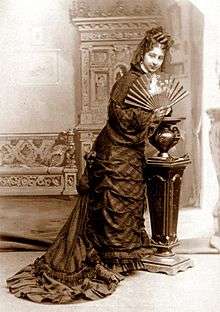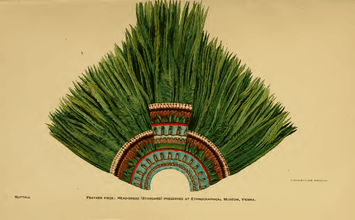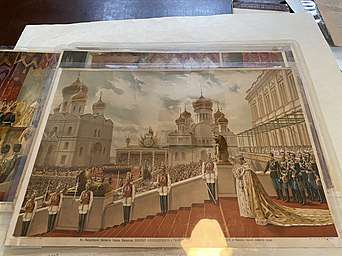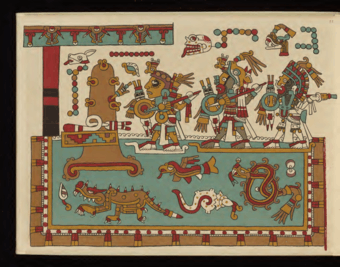Zelia Nuttall
Zelia Maria Magdalena Nuttall (6 September 1857, San Francisco – 12 April 1933, Coyoacán, Mexico) was an American archaeologist and anthropologist specialised in pre-Aztec Mexican cultures and pre-Columbian manuscripts. She discovered two forgotten manuscripts of this type in private collections, one of them being the Codex Zouche-Nuttall. She was one of the first to identify and recognise artefacts dating back to the pre-Aztec period.[1]
Zelia Nuttall | |
|---|---|
 Zelia Nuttall | |
| Born | September 6, 1857 |
| Died | April 12, 1933 (aged 75) |
| Nationality | United States |
| Occupation | archaeologist |
| Known for | Mexican archaeology |
| Spouse(s) | Alphonse Pinart, div. 1888 |
| Children | Nadine Nuttall Laughton |
| Parent(s) | Robert Kennedy Nuttall, Magdalena Parrott |
| Relatives | George Nuttall |
Biography
Nuttall was born in San Francisco in 1857 to Irish father Dr. Robert Kennedy Nuttall and Mexican-American mother Magdalena Parrott.[2] She married the French anthropologist Alphonse Louis Pinart in 1880 and had a child, but they divorced in 1888;[1] at the time of the divorce she left the Catholic Church.[3]
She was educated in France, Germany, and Italy, and at Bedford College, London. During Nuttall’s first trip to Mexico in 1884 with her family, she worked for the National Museum of Anthropology in Mexico City as an Honorary Professor of Archaeology.[2] While visiting Teotihuacan that year, she collected terracotta heads from San Juan Teotihuacan.[4] The pieces had been studied before but they had not been properly dated or understood. This was the foundation of the publication which would lead her into prominence, the "Terra Cotta Heads of Teotihuacan" for the American Journal of Archaeology (1886)[5]. Because of the success of this article, she was appointed Special Assistant of the Peabody Museum of Archaeology and Ethnology at Harvard.
Frederic Putnam, leading American anthropologist and curator of Peabody from 1875 to 1909, and German-American anthropologist Franz Boas saw her as an excellent mediator between Americanist circles in different countries because of her education and cosmopolitan relations. In his 1886 annual report for the museum, Putnam praised Nuttall as “familiar with the Nahuatl language, having intimate and influential friends among the Mexicans, and with an exceptional talent for linguistics and archaeology.”[1] Her family background made of her a particularly ideal partner for relations with Mexico. This would play an important role in the creation of the institution of international cooperation Escuela Internacional de Arqueología y Etnología Americana[6].

From 1886 to 1899 she followed her family to Europe and lived mainly in Dresden. In 1902 she moved to Mexico City in an eighteenth-century house called Quinta Rosalía, which was her main residence until her death. Her home, which she renamed Casa de Alvarado, became a meeting place for foreign Americanists, scientists and intellectuals[6]. The large land she owned allowed her to develop her passion for gardening. She studied Mexican garden art, medicinal herbs, and undertook a collection of unknown local seeds in the United States, which she intended to introduce. She also participated in the introduction of taro cultivation in the state of Orizaba.
Nuttall had seen many archaeological artefacts in museums and visited several sites, but it was in 1910 that she made, with the agreement of the Mexican authorities, her first important excavations on Isla de Sacrificios, where she discovered the ruins of a site of human sacrifice. During this expedition, her supervisor, Salvador Batres, claimed the discovery himself. She resigned from her position at the National Museum of Anthropology and wrote "The Island of Sacrificios", published in 1910 in American Anthropologist. It was a detailed account of the site's discovery and excavation which prompted the Mexican government to have Batres replaced.[8]
Nuttal was a member of several academic institutions, including the Harvard Peabody Museum and the National Museum of Anthropology in Mexico City and she carried out most of her activities without pay and on a fee-for-service basis. She did, however, have some patrons, including Phoebe Hearst, mother of William Hearst, founder of the Phoebe A. Hearst Museum of Anthropology in Berkeley, to which Nuttall donated many pieces.
Nuttall was also the basis for D.H. Lawrence's character Mrs. Norris in his novel The Plumed Serpent.[2]
Defence of Mesoamerican cultures
Nuttall investigated Mexico’s past to give recognition and pride to its present at a time where Western archaeology favoured salacious narratives of ancient Mesoamericans. In 1897, Nuttall published Ancient Mexican Superstitions in The Journal of American Folklore.[9] In it, she criticised the representation of ancient Mexicans as “bloodthirsty savages, having nothing in common with civilised humanity”. “Such a hold upon the imagination that it effaces all other knowledge about the ancient civilisation of Mexico”, she wrote. She hoped her work would “lead to a growing recognition of the bonds of universal brotherhood which unite the present inhabitants of this great and ancient continent to their not unworthy predecessors.”
Outside of her work in anthropology and archaeology, Nuttall, partnered with Phoebe Hearst, worked to educate and preserve the heritage of indigenous Mexicans. One of her students was Manuel Gamio, who would eventually become one of Mexico's most famous archaeologists.
Near the end of her life, Nuttall advocated for the revival of Mexican traditions that had been eradicated by Spanish conquest. In 1928, she called for a renewed national celebration of the indigenous New Year, which was traditionally observed twice annually by numerous Mesoamerican cultures.[10] That year, Mexico City celebrated the Aztec New Year for the first time since 1519.
Penn Museum Expedition to Russia

Zelia Nuttall was sent to Russia in 1894 as a representative of the Penn Museum to attend the coronation of Czar Nicholas II and Czarina Alexandra.[11] At the time, the Penn Museum wanted to establish exchanges with Russian museums, and to this end offered financial assistance to Russian archaeological excavations in exchange for a share of the discoveries. Sara Yorke Stevenson, a member of the Penn Museum’s Board of Managers and Curator of the Egyptian Section, chose Nuttall as the Museum’s representative because of Nuttall’s knowledge of Russian. The opportunity for Nuttall to travel to Russia opened when Phoebe Apperson Hearst, the mother of William Randolph Hearst, cancelled her trip to the coronation, and passed the opportunity to the Penn Museum, along with the funds to acquire a collection.[11]
When Nuttall was in Moscow to attend the coronation of Nicholas II, she set up several exchanges between Russian museums and the Penn Museum. In addition, she visited the Pan-Russian Industrial and Art Exhibition at Nizhny Novgorod (known as Gorky from 1932 to 1990), where she inspected numerous artifacts from regions as distant as Siberia, and collected more than 400 items from Russia, Finland, Poland, and Russian Turkestan. The artifacts included religious objects, musical instruments, pottery, color lithographs of the 1894 Russian coronation ceremony, and more. She also acquired a photograph collection illustrating customs of the Kyrgyz people from the vicinity of Tashkent and Samarkand.[11]
Publications
Ancient manuscripts

Nuttall was known for her ability to find lost or forgotten manuscripts and bring them to the attention of scholars.
- She traced the Zapotecan manuscript, now known as the Codex Zouche-Nuttall, in the library of its owner, Baron Zouche of Haryngworth. A facsimile with an introduction by Nuttall was published in 1902 by the Peabody Museum[12].
- In 1890, she identified in the National Central Library of Florence the Codex Magliabecchiano, which she published in 1903 through the University of California under the title The Book of the Life of the Ancient Mexicans[13]. On that occasion, she entered into conflict with the Duke of Loubat, who published it in 1904 without crediting her with the discovery.[14]
- In 1911, she found at the National Library of Spain the unfinished text of Francisco Cervantes de Salazar's Crónica de la Nueva España, dating from about 1560 and tracing the history of the conquest of Mexico. This was published in 1914[15][16]
- She discovered a manuscript in National Library at Madrid relating to the prevention and cure of plague in Spain in 1600-1601. This was published in english translation in 1912[17]
- She collected the manuscripts of Francis Drake and John Hawkins contained in the National Archives of Mexico, as well as in collections in New York, Spain, Italy, France and England (Bodleian Library, British Museum and Public Archives of London). The set was published in 1914 by the Hakluyt Society of London under the title A New Light on Drake. To complete the work, she traveled in 1916 to the Juan de Fuca Strait between Vancouver Island and Washington State to confirm the details of Drake's travels.
Works
- Nuttall, Zelia (1886). "The Terracotta Heads of Teotihuacan". American Journal of Archaeology. 2: 318–330. OCLC 25124813.
- Nuttall, Zelia (1888). Standard or head-dress? An historical essay on a relic of ancient Mexico. Cambridge, Mass.: Peabody Museum of American Archaeology and Ethnology. OCLC 313707016.
- Nuttall, Zelia (1891). The atlatl or spear-thrower of the ancient Mexicans. Cambridge, Massachusetts: Peabody Museum of American Archaeology and Ethnology. OCLC 3536622.
- Nuttall, Zelia (1892). On ancient Mexican shields : an essay. Leiden: P.W.M. Trap. OCLC 458945327.
- Nuttall, Zelia (1901). The fundamental principles of Old and New World civilizations : a comparative research based on a study of the Ancient Mexican religious, sociological and calendrical systems. Cambridge, Massachusetts: Peabody Museum of American Archaeology and Ethnology. OCLC 219742748.
- Nuttall, Zelia (1983) [1903]. The book of the life of the ancient Mexicans : containing an account of their rites and superstitions : an anonymous Hispano-Mexican manuscript preserved at the Biblioteca nazionale centrale, Florence, Italy. Berkeley: University of California Press. OCLC 10719260.
- Nuttall, Zelia (1904). A Penitential Rite of the Ancient Mexicans. Archaeological and Ethnological Papers of the Peabody Museum. 1. Cambridge, Massachusetts. OCLC 2991502.
- Nuttall, Zelia (1906). "The astronomical methods of the ancient Mexicans". In Laufer, Berthold (ed.). Boas Anniversary Volume. Anthropological papers written in honor of Franz Boas, Professor of Anthropology in Columbia University. New York: G.E. Stechert & Co. pp. 290–298.
- Nuttall, Zelia (1910). "The island of Sacrificios". American Anthropologist. 12 (2): 257–295. doi:10.1525/aa.1910.12.2.02a00070. OCLC 29606682.
- Nuttall, Zelia; Pedro Sarmiento de Gamboa; Nuno da Silva (1914). New Light on Drake: Documents Relating to his Voyage of Circumnavigation 1577-1580. London: Hakluyt Society. OCLC 2018572.
Notes
- Tozzer, Alfred M. (1933). "Zelia Nuttall". American Anthropologist. 35 (3): 475–482. doi:10.1525/aa.1933.35.3.02a00070.
- Adams, Amanda (2010). Ladies of the field : early women archaeologists and their search for adventure. Vancouver ; Berkeley [Calif.]: Greystone Book. pp. 65–87. ISBN 9781553654339.
- James, Edward T.; James, Janet Wilson; Boyer, Paul S., eds. (1971). Notable American Women, 1607–1950: A Biographical Dictionary, Volume 2. Cambridge, MA: Harvard University Press. p. 640. ISBN 9780674627345.
- Nuttall, Zelia; Bowditch, Charles P; Burlen, Robert; Hoffman, Wilhelm; Mead, Frances Harvey; Putnam, F. W; Röhl, Adolar; Whitehead, Gilbert; Bedford College (1886). Nuttall, Zelia, papers 1886-1912. OCLC 223352565.
- "Zelia Maria Magdalena Nuttall | American archaeologist". Encyclopedia Britannica. Retrieved 2018-03-09.
- Ruiz Martinez, Apen (2006). "Zelia Nuttall e Isabel Ramírez: las distintas formas de practicar y escribir sobre arqueología en el México de inícios del siglo XX". Cadernos Pagu. 27.
- Nuttall, Zelia (1895). Ancient Mexican feather work at the Columbian historical exposition at Madrid. Washington, DC: US Government Printing Office.
- "Zelia Nuttall: The Queen of Mexican Archaeology". Rejected Princesses. Retrieved 2018-12-06.
- Nuttall, Zelia (1897). "Ancient Mexican Superstitions". The Journal of American Folklore. 10 (39): 265–281. doi:10.2307/533278. ISSN 0021-8715. JSTOR 533278.
- Nuttall, Zelia (1928). "New Year of Tropical American Indigenes". Pan American Miscellany.
- Pezzati, Alex (2000). "A Crowning Achievement: Zelia Nuttall in Czarist Russia". Expedition. 42: 8.
- Nuttall, Zelia (1902). Codex Nuttall; facsimile of an ancient Mexican codex belonging to Lord Zouche of Harynworth, England. Cambridge, Massachusetts: Peabody Museum of American Archaeology and Ethnology.
- Nuttall, Zelia (1903). The book of the life of the ancient Mexicans : containing an account of their rites and superstitions : an anonymous Hispano-Mexican manuscript preserved at the Biblioteca nazionale centrale, Florence, Italy. Berkeley, California: University of California Press.
- "Wikiwix's cache". archive.wikiwix.com. Archived from the original on 2011-02-17. Retrieved 2019-03-08.
- Nuttall, Zelia (1913). Certain manuscripts relating to the history of Mexico and the missing text of the Magliabecchi manuscript in the National Gallery, Madrid. Eighteenth International Congress of Americanists Held at London, 1912. pp. 449–454.
- Francisco, Cervantes de Salazar (1914). Magallón, M. (ed.). Crónica de la Nueva España [Chronicle of New Spain] (in Spanish). Madrid: Hispanic Society of America. OCLC 1042916880.
- Nuttall, Zelia (1912). "An Historical Document relating to the Prevention and Cure of Plague in Spain in 1600-1601". The Journal of Hygiene. 12 (1): 46–48. doi:10.1017/S0022172400017010. PMC 2167273. PMID 20474482.
References
- Chiñas, Beverley Newbold (1989). "Zelia Maria Magdalena Nuttall". In Ute Gacs; Aisha Khan; Jerrie McIntyre; Ruth Weinberg (eds.). Women Anthropologists: Selected Biographies (Illini Books edition, Reprint of Westport, CT: Greenwood Press original [©1988]. ed.). Urbana: University of Illinois Press. pp. 269–274. ISBN 978-0-252-06084-7. OCLC 19670310.
- Tozzer, Alfred M. (July–September 1933). "Zelia Nuttall" (PDF). American Anthropologist. New Series. Arlington, VA: American Anthropological Association and affiliated societies. 35 (3): 475–482. doi:10.1525/aa.1933.35.3.02a00070. OCLC 1479294. Archived from the original (PDF online reproduction) on 2008-10-31.
- Nuttall's life and work was chronicled in Amanda Adams' book Ladies Of The Field
- This article incorporates text from a publication now in the public domain: Gilman, D. C.; Peck, H. T.; Colby, F. M., eds. (1905). New International Encyclopedia (1st ed.). New York: Dodd, Mead. Missing or empty
|title=(help)
External links
- Zelia Nuttall's obituary by Alfred M. Tozzer on American Ethnography. (The obituary originally appeared in American Anthropologist July - September, 1933, New Series 35(3): 475-482.)
- Works by Zelia Nuttall at Project Gutenberg
- Works by or about Zelia Nuttall at Internet Archive